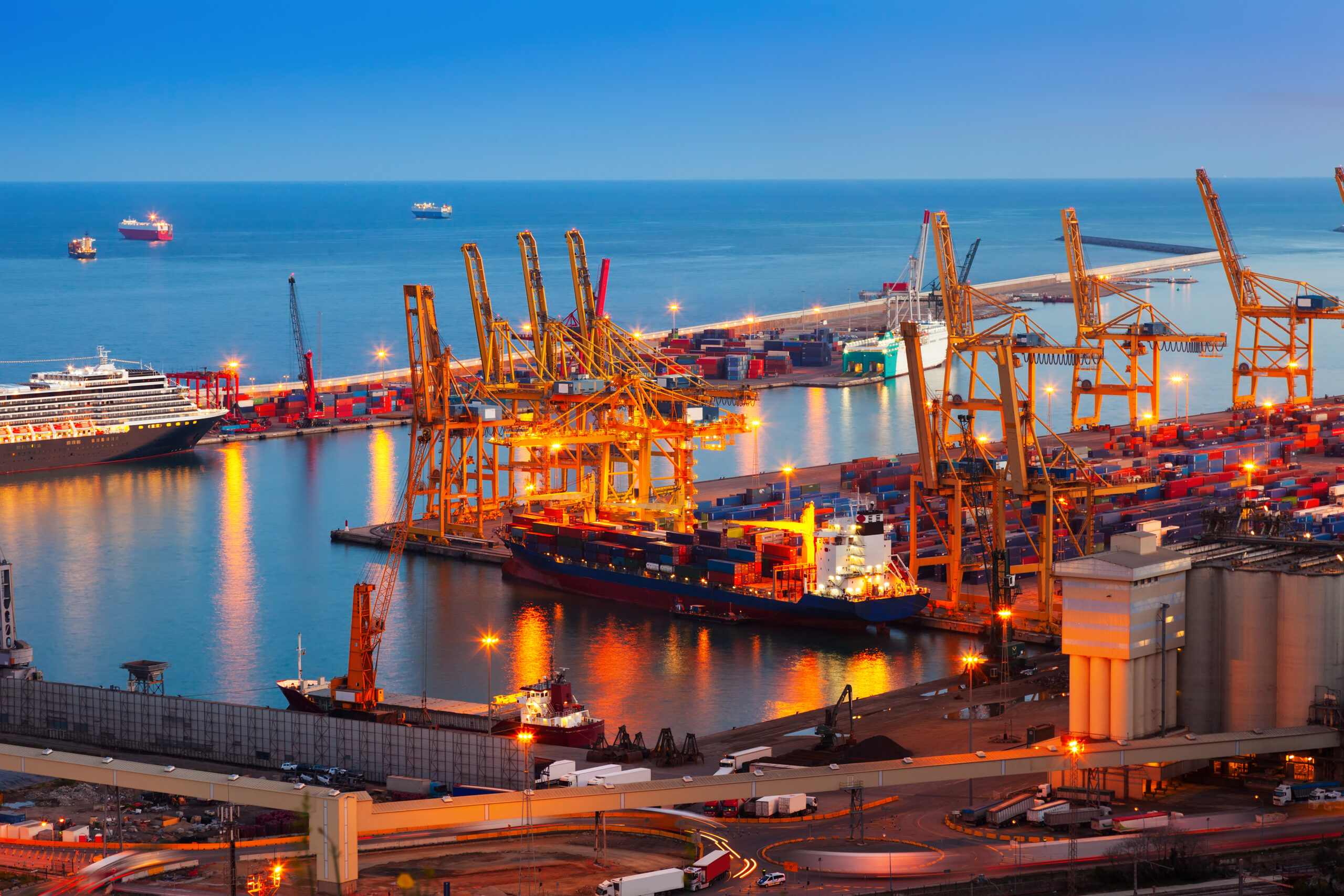Why the Ports Bill, 2025 Matters
The Ports Bill, 2025, is one of the most significant maritime reforms in recent history. It marks the replacement of the Indian Ports Act, 1908, a colonial framework that had long outlived its relevance. With global trade expanding, India’s port system needed a governance model that ensures environmental safeguards, better coordination between the Centre and states, and more transparency in tariffs and decision-making. This Bill, passed in Parliament in August 2025, is a forward-looking attempt to align India’s maritime laws with international standards and to prepare the industry for future challenges.
Beyond legislative change, the Bill carries strategic importance for India’s ambition to become a global maritime power by 2047, coinciding with the centenary of independence. With over 95% of India’s trade volume moving through maritime routes, modernizing port governance is central to reducing logistics costs and improving competitiveness. By focusing on institutional clarity, environmental compliance, dispute resolution, and digitalization, the Bill creates a foundation not only for operational efficiency but also for sustainable growth, benefiting industries, traders, and coastal communities alike.
From Colonial Legacy to Modern Framework
The Indian Ports Act of 1908 was conceived during British rule when ports were primarily used for resource extraction and limited trade. Its provisions were narrow, emphasizing basic safety, conservancy, and revenue collection without considering the complexities of modern logistics, containerization, and private sector participation. Over time, as India’s economy globalized, the law became outdated, leaving gaps in environmental protection, governance coordination, and digital integration. This created inefficiencies and inconsistencies across major and non-major ports, slowing down India’s maritime competitiveness.
The Ports Bill, 2025 represents a fundamental restructuring of this outdated system. It introduces forward-looking provisions that align with international conventions, establishes new governance frameworks, and enforces transparency in tariffs and processes. Unlike the 1908 Act, it explicitly addresses environmental safeguards, digitalization, and ease of doing business. It also strengthens the role of both central and state governments in managing ports, ensuring that growth is balanced with sustainability. In essence, the Bill shifts India’s maritime governance from a fragmented colonial legacy to a globally competitive modern framework.

Institutional Overhaul: MSDC and State Maritime Boards
One of the most critical reforms in the Bill is the establishment of the Maritime State Development Council (MSDC). This council, chaired by the Union Ports Minister, brings together state ministers, naval and coast guard representatives, and senior officials to coordinate policies across India’s maritime sector. Its role includes standardizing data-sharing, framing guidelines for tariff transparency, and developing national port strategies. This central body ensures better cooperation between states and the Centre, reducing fragmentation that previously hindered maritime growth.
Alongside the MSDC, the Bill gives statutory recognition to State Maritime Boards, responsible for overseeing non-major ports. These boards manage licensing, regulate safety and security standards, oversee tariff-setting, and enforce compliance with environmental regulations. By empowering states while ensuring national-level coordination, the Bill strikes a balance between autonomy and oversight. This institutional clarity eliminates confusion, allowing ports to develop more efficiently and investors to operate with confidence. The twin pillars of MSDC and State Maritime Boards thus form the backbone of India’s new port governance structure.
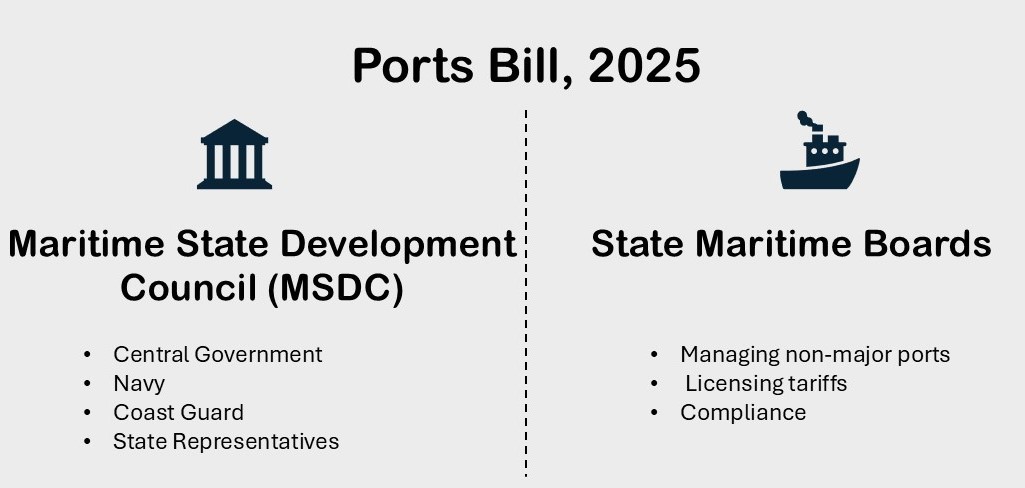
Dispute Resolution Mechanism: Accessible & State-led
Port-related disputes in India often dragged through lengthy court battles, discouraging investors and creating bottlenecks in operations. The Ports Bill, 2025 addresses this by mandating each state to set up a Dispute Resolution Committee (DRC). These committees will resolve disputes involving non-major ports, service providers, and users, offering a quicker, more specialized alternative to civil courts. The move reduces dependency on traditional litigation and promotes an investor-friendly environment where issues can be resolved efficiently.
The Bill also ensures a clear appellate structure. Decisions of the DRC can be challenged in the High Court, but civil courts are explicitly excluded from jurisdiction to avoid parallel litigation. This tiered system strengthens legal clarity while safeguarding fairness. For port operators, exporters, and businesses that depend on maritime trade, this mechanism means faster resolution, lower legal costs, and improved trust in governance. By simplifying conflict resolution, the Bill creates a stable environment necessary for long-term investment and growth in the port sector.
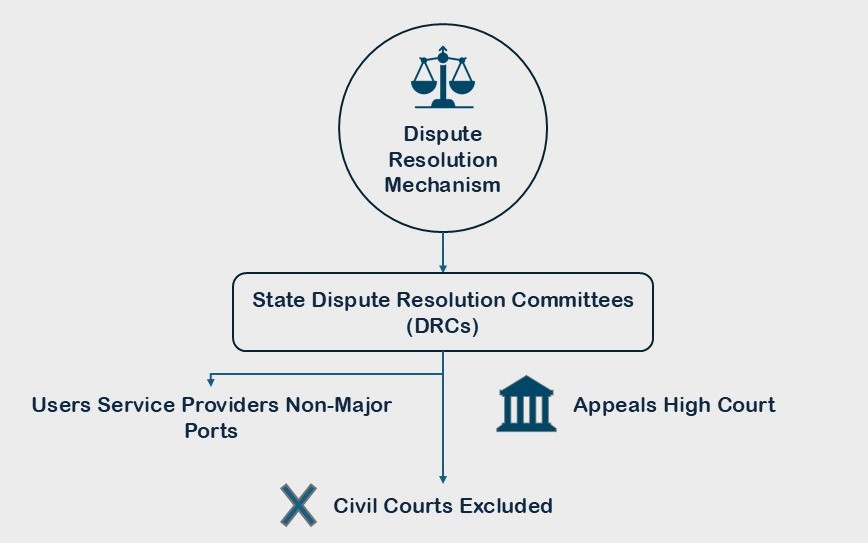
Tariff Transparency & Governance
Opaque tariff-setting has long been a challenge in India’s port sector. Different models across major and non-major ports often led to unpredictability, reducing investor confidence and complicating trade logistics. The Ports Bill, 2025 tackles this issue head-on by introducing a transparent tariff mechanism. Major ports will have tariffs fixed by their respective Port Authority Boards or corporatized entities, while non-major ports will follow rules set by State Maritime Boards or concessionaires under clear guidelines.
A key innovation is the mandatory online publication of tariffs. This digital-first approach ensures that all stakeholders, exporters, importers, shipping companies, and logistics firms, have easy access to tariff information. By eliminating opacity and standardizing practices, the Bill reduces opportunities for arbitrariness and corruption. The clarity brought to tariff-setting also aligns India with global practices, making it easier for international players to engage with Indian ports. In the long run, tariff transparency enhances competitiveness, predictability, and trust in the maritime ecosystem.
Environmental & Safety Standards: Global Alignment
Ports, while critical for trade, often pose serious environmental risks including oil spills, waste discharge, and ballast water contamination. The Ports Bill, 2025 makes India’s maritime framework more environmentally responsible by mandating compliance with international conventions like MARPOL (Marine Pollution Convention) and the Ballast Water Management Convention. This ensures that Indian ports meet global ecological standards, reducing risks to marine biodiversity and coastal communities.
The Bill also requires ports to establish waste reception facilities, disaster preparedness systems, and worker welfare provisions. Regular audits by the central government will enforce accountability, ensuring compliance across all states. This shift makes sustainability central to India’s maritime policy rather than an afterthought. With climate change and ecological sensitivity becoming global priorities, these measures position India as a responsible maritime nation. Beyond environmental protection, the reforms also enhance safety and resilience, ensuring that ports can withstand accidents and natural disasters more effectively
Digitalization & Ease of Doing Business
Digitalization is at the heart of the Ports Bill, 2025. For decades, paperwork-heavy processes plagued port operations, leading to inefficiencies, delays, and higher logistics costs. The new Bill mandates digital platforms for data collection, tariff publication, and procedural workflows, making operations faster and more transparent. This step is crucial for improving India’s global ranking in Ease of Doing Business and enhancing its attractiveness to foreign investors.
By reducing manual interventions, digital systems also minimize scope for corruption and human error. The Bill aligns India’s ports with global trends like Port Community Systems and single-window clearance, though the latter still needs full adoption. Once fully implemented, digitalization will transform India’s maritime sector into a modern, technology-driven ecosystem where cargo handling, customs, and regulatory approvals are seamlessly integrated. For exporters, shipping companies, and logistics firms, this means lower costs, faster turnaround times, and greater reliability.
Stakeholder Benefits: Who Gains from the Bill?
The Ports Bill, 2025 is designed to benefit multiple stakeholders. For port operators, it provides clearer governance and autonomy, backed by predictable tariff and compliance frameworks. State governments gain control over non-major ports, giving them more agency in regional economic development. For the central government, the creation of MSDC ensures greater oversight and strategic planning, allowing for coordinated development across India’s coastline.
Exporters and MSMEs benefit directly through reduced logistics costs, streamlined procedures, and transparent tariffs. Coastal communities, often at risk from unchecked port expansion, gain protection through stronger environmental safeguards. Investors, both domestic and international, find the clarity in governance and dispute resolution mechanisms reassuring, making Indian ports more attractive for private participation. The Bill thus balances economic growth, environmental protection, and stakeholder confidence, creating a holistic foundation for India’s maritime progress.
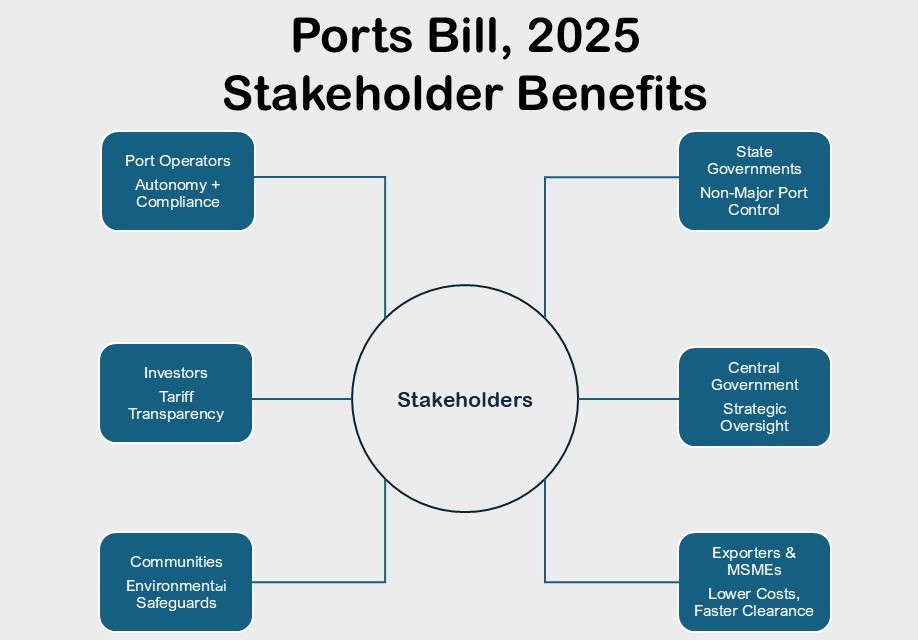
International Comparisons: Lessons from Global Leaders
Global best practices provide valuable insights into India’s maritime reforms. For instance, Canada’s Canada Marine Act (1998) created Port Authorities with commercial freedom for major ports while devolving smaller ports to local governments. This balance of central control and local autonomy is similar to India’s approach through MSDC and State Maritime Boards. It ensures efficiency while respecting regional dynamics.
The United States, meanwhile, has focused heavily on security through the Maritime Transportation Security Act (2002) and the SAFE Ports Act (2006). These laws emphasize risk-based security, supply chain accountability, and inter-agency coordination. Singapore’s port model, globally admired, demonstrates how digitalization, smart port technologies, and integrated logistics planning can make ports globally competitive. The Ports Bill, 2025 aligns with these frameworks in governance and environmental safeguards, but India can still learn from global leaders on security frameworks, digital integration, and smart technology adoption.
Gaps & Areas for Improvement
While the Ports Bill, 2025 represents a landmark shift in India’s maritime governance, it is not without shortcomings. To become a truly world-class framework, several areas require further refinement and international benchmarking. These gaps, if addressed, could significantly improve accountability, efficiency, and competitiveness.
1. Absence of Appeal Mechanism for Conservator Penalties
The Bill empowers port conservators to impose penalties for violations. However, it does not provide a dedicated appeal mechanism against such decisions. This creates a risk of arbitrary enforcement without adequate checks and balances. In comparison, countries like the UK and Canada have layered appeal systems, ensuring fairness in regulatory enforcement. Introducing an independent appellate authority or tribunal within the maritime governance structure could safeguard stakeholders from misuse of power while maintaining accountability.
2. Limited Oversight of Inspection Powers
The Bill grants wide-ranging inspection and compliance powers to authorities, but without strong oversight or grievance redressal. This leaves room for potential overreach, creating uncertainty for port operators and investors. Best practices globally, such as in Singapore’s Maritime and Port Authority, include oversight committees and audit systems to monitor inspections. India could strengthen this by mandating transparency reports, periodic reviews, and an appeal process for contested inspection findings.
3. Incomplete Digital Integration
Although the Bill emphasizes digitalization, it falls short of mandating a fully integrated Port Community System (PCS) or Maritime Single Window, which are global standards under the IMO’s FAL Convention. These systems allow shipping lines, customs, port authorities, and logistics providers to interact seamlessly on a single platform, reducing delays and costs. Without such integration, India risks lagging behind peers like Singapore, Rotterdam, and Shanghai, where smart-port ecosystems have revolutionized efficiency. A stronger push for end-to-end digital infrastructure is essential.
4. Weak Maritime Security Framework
Security receives limited emphasis in the Bill. While environmental compliance is well-covered, the security of cargo, ships, and port facilities, especially against terrorism, smuggling, and cyber threats, remains inadequately addressed. By contrast, the U.S. Maritime Transportation Security Act (2002) and the SAFE Ports Act (2006) created robust inter-agency frameworks for port security, including risk-based cargo inspections and cybersecurity protocols. India’s ports, given their strategic location in the Indo-Pacific, would benefit from a similar comprehensive maritime security strategy embedded within the law.
5. Slow Adoption of Smart Port Technology
The Bill mentions digitalization but stops short of mandating the use of smart port technologies like IoT sensors, AI-driven logistics, blockchain for trade documentation, and digital twins for predictive maintenance. These technologies are already being adopted in advanced ports across Europe and East Asia, enabling them to reduce turnaround times and optimize resource use. India’s omission here risks slowing its progress toward globally competitive port operations. A phased roadmap for smart technology adoption could close this gap.
6. Limited Green Transition Roadmap
While the Bill strengthens environmental safeguards, it does not chart a clear path for India’s green shipping transition. Global ports are increasingly investing in shore power facilities, green hydrogen bunkering, and carbon-neutral infrastructure. India’s ports, under this Bill, are expected to comply with international conventions but lack a proactive mandate for sustainability innovation. A roadmap aligning with IMO’s 2050 decarbonization targets would ensure India’s ports remain competitive in a future where green logistics will be a trade determinant.
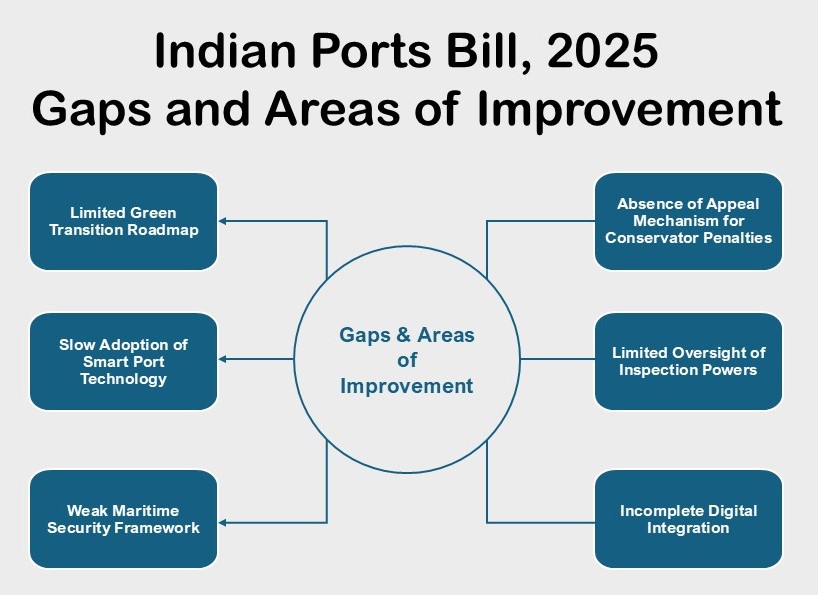
Vision 2047: India as a Maritime Leader
By 2047, India aims to position itself among the world’s top maritime powers, rivaling global leaders like Singapore, Rotterdam, and Shanghai. The Ports Bill, 2025 plays a critical role in this journey by laying the foundation for efficient governance, environmental sustainability, and digital transparency. Alongside allied reforms like the Merchant Shipping Act, 2025 and Carriage of Goods by Sea Act, 2025, it creates a comprehensive legal ecosystem for maritime development.
The vision for 2047 requires not just legal reform but also investments in green shipping practices, smart port infrastructure, and stronger international collaborations. With its strategic location in the Indo-Pacific, India is well-placed to become a global logistics hub. The Ports Bill, by resolving long-standing governance bottlenecks, sets India on course for this transformation. However, consistent follow-through, capacity building, and global benchmarking will be key to turning the vision of maritime leadership into reality.
FAQs on Ports Bill, 2025
Q1. What does the Ports Bill, 2025 replace?
It replaces the Indian Ports Act, 1908, a colonial law that no longer matched India’s trade needs.
Q2. How will tariffs be regulated under the new law?
Tariffs will be set by Major Port Boards or State Maritime Boards and must be published online to ensure transparency.
Q3. What are the environmental provisions?
The Bill mandates compliance with international conventions, requires ports to provide waste reception facilities, and enforces disaster preparedness systems.
Q4. How will disputes be resolved?
Through Dispute Resolution Committees (DRCs) at the state level, with appeals directed to High Courts.
Q5. How does it affect exporters and MSMEs?
By cutting costs, streamlining clearance, and improving transparency, exporters and MSMEs will face fewer hurdles.
Q6. What global practices could India still adopt?
India can further adopt single-window clearance, smart port technologies, and advanced security systems to match global leaders.
Conclusion: A Watershed Moment for Indian Maritime Policy
The Ports Bill, 2025 is more than a legislative update; it is a structural shift in how India manages its maritime assets. By replacing a colonial-era framework with a modern governance system, it brings institutional clarity, stronger environmental protections, and digital efficiency. For stakeholders across the spectrum—states, businesses, exporters, communities, and investors—it offers both certainty and opportunity.
Still, the Bill is not the final word. To truly lead globally, India must close gaps in appeals, digital integration, and security frameworks. If these are addressed, the Ports Bill could become the cornerstone of India’s maritime renaissance, propelling the nation toward its vision of becoming a maritime powerhouse by 2047.
Reference: The Indian Ports Bill, 2025
